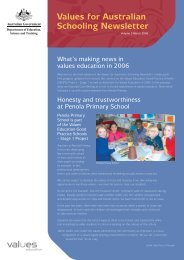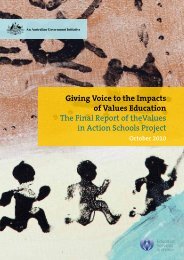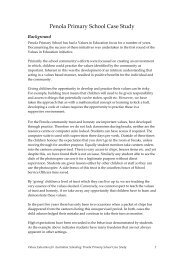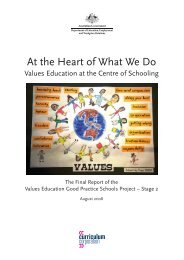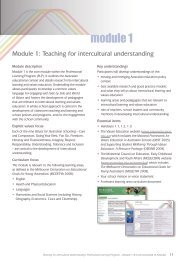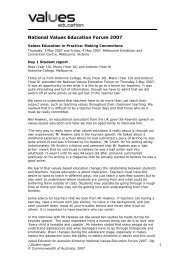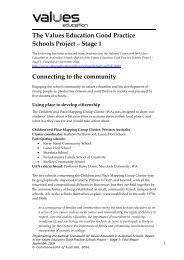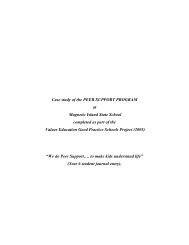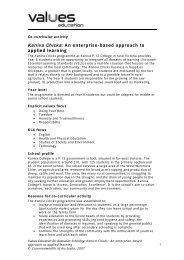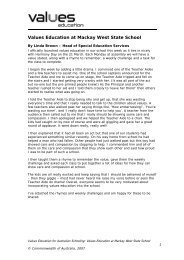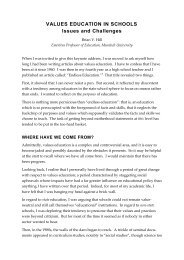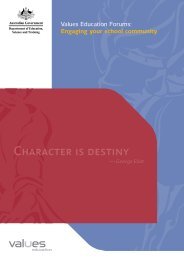Giving Voice to the Impacts of Values Education The Final Report of ...
Giving Voice to the Impacts of Values Education The Final Report of ...
Giving Voice to the Impacts of Values Education The Final Report of ...
You also want an ePaper? Increase the reach of your titles
YUMPU automatically turns print PDFs into web optimized ePapers that Google loves.
On <strong>the</strong> matter <strong>of</strong> method<br />
In common with <strong>the</strong> VEGPSP projects, <strong>the</strong> VASP<br />
methodology included:<br />
• <strong>the</strong> action research model <strong>to</strong> guide<br />
cluster projects<br />
• engagement and attachment <strong>of</strong> teacher-educa<strong>to</strong>r<br />
University Advisors <strong>to</strong> support each cluster<br />
• guidelines, templates and face-<strong>to</strong>-face briefing<br />
sessions <strong>to</strong> support cluster projects<br />
• collaborative support <strong>to</strong> clusters from<br />
jurisdictional, Catholic education and<br />
independent schools sec<strong>to</strong>r <strong>of</strong>ficers<br />
• a scheduled project reporting regime.<br />
In addition <strong>to</strong> <strong>the</strong>se common building blocks, <strong>the</strong><br />
VASP methodology was augmented by several new<br />
approaches, designed <strong>to</strong> ga<strong>the</strong>r more evidence about<br />
<strong>the</strong> impacts <strong>of</strong> effective values education practice:<br />
• Quantitative data sets – Pre- and post-project<br />
teacher perception surveys were conducted<br />
across all 15 clusters <strong>to</strong> capture teachers’<br />
perceptions about <strong>the</strong>ir role in values education<br />
before and after <strong>the</strong> enactment <strong>of</strong> values projects.<br />
• Collection <strong>of</strong> a broad range <strong>of</strong> ‘artefacts’ from<br />
<strong>the</strong> cluster work – Each cluster project ga<strong>the</strong>red<br />
a range <strong>of</strong> data relating <strong>to</strong> <strong>the</strong>ir specific projects,<br />
which included student work samples and<br />
artefacts, student survey data, school newsletters,<br />
units <strong>of</strong> work, attendance and o<strong>the</strong>r school<br />
environment data, as well as teacher and parent<br />
observations.<br />
• <strong>The</strong> use <strong>of</strong> <strong>the</strong> Most Significant Change (MSC)<br />
technique <strong>of</strong> ga<strong>the</strong>ring project participant<br />
accounts <strong>of</strong> change.<br />
<strong>The</strong> action research process <strong>of</strong> <strong>the</strong> VASP<br />
<strong>The</strong> VASP involved participants in an ongoing action research cycle marked by four phases: reflect,<br />
design/plan, act and evaluate/observe. This reflexive cycle is illustrated in Figure 2.<br />
reflect<br />
reflect<br />
reflect<br />
reflect<br />
observe<br />
plan<br />
observe<br />
plan<br />
act<br />
act<br />
continual improvement<br />
Figure 2: <strong>The</strong> action research cycle, based on Kemmis & McTaggart 1988; Schmuck 1998<br />
16 <strong>Giving</strong> <strong>Voice</strong> <strong>to</strong> <strong>the</strong> <strong>Impacts</strong> <strong>of</strong> <strong>Values</strong> <strong>Education</strong>: <strong>The</strong> <strong>Final</strong> <strong>Report</strong> <strong>of</strong> <strong>the</strong> <strong>Values</strong> in Action Schools Project



